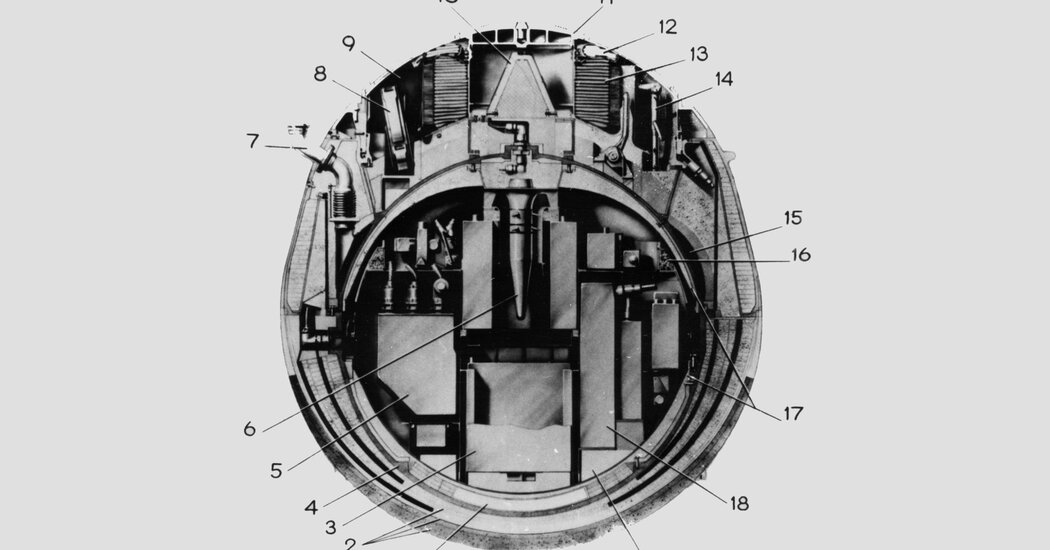After looping through space for 53 years, a wayward Soviet spacecraft called Kosmos-482 returned to Earth, entering the planet’s atmosphere at 9:24 a.m. Moscow time on Saturday, according to Roscosmos, the state corporation that runs the Russian space program.
Designed to land on the surface of Venus, Kosmos-482 may have remained intact during its plunge. It splashed down in the Indian Ocean west of Jakarta, Indonesia, Roscosmos said.
Kosmos-482 was launched on March 31, 1972, but became stranded in Earth’s orbit after one of its rocket boosters shut down prematurely. The spacecraft’s return to Earth was a reminder of the Cold War competition that prompted science fiction-like visions of Earthbound powers projecting themselves out into the solar system.
“It recalls a time when the Soviet Union was adventurous in space — when we were all maybe more adventurous in space,” said Jonathan McDowell, an astrophysicist at the Harvard & Smithsonian Center for Astrophysics who tracks objects launched into orbit. “It’s a bit of a bittersweet moment in that sense.”
While America had won the race to the moon, the Soviet Union, through its Venera program, kept its sights on Venus, Earth’s twisted sister.
From 1961 to 1984, the Soviets launched 29 spacecraft toward the shrouded world next door. Many of those missions failed, but more than a dozen did not. The Venera spacecraft surveilled Venus from orbit, collected atmospheric observations while gently descending through its toxic clouds, scooped and studied soil samples and sent back the first, and only, pictures we have from the planet’s surface.
“Kosmos-482 is a reminder that, 50 years ago, the Soviet Union reached the planet Venus. Here is a physical artifact of that project, of that time,” said Asif Siddiqi, a historian at Fordham University who specializes in Soviet-era space and scientific activities. “There’s something oddly strange and compelling to me about this, about how the past still continues to orbit the Earth.”
Half a century later, as nations plot a return to the moon and fling their probes toward Mars, Jupiter and various asteroids, a lonely Japanese space probe is the only vehicle orbiting Venus. Other proposed missions have faced delays and uncertain futures.
During the space race, putting boots on the moon was the biggest prize — but the other worlds in our solar system were calling, too. As the United States focused increasingly on Mars, the Soviet Union turned its sights toward the second rock from the sun.
“Both sides had an interest in Mars at that time, but Venus was an easier target,” said Cathleen Lewis, curator of international space programs and spacesuits at the Smithsonian Institution’s National Air & Space Museum.
Nearly the same size as Earth, Venus is often referred to as its twin, though it’s about as un-Earthlike as rocky planets get. It is sheathed in a thick atmosphere of carbon dioxide and hidden beneath miles of sulfuric acid clouds. A casualty of a runaway greenhouse effect, the Venusian surface is a sweltering 870 degrees Fahrenheit, and crushed by atmospheric pressures about 90 times greater than those of Earth.
“How do you build something that can survive a multimonth journey across the solar system, get to a planet through a thick atmosphere, get to the ground and not melt or be crushed, and take pictures?” Dr. Siddiqi asked. “It’s kind of an incredible problem to think about solving in the 1960s.”
Undeterred by the challenges posed by such a punishing world, the Soviets hurled their hardware at Venus, again and again. And there was no template for how to do it at the time.
“You literally were inventing the thing you want to send to Venus,” Dr. Siddiqi said. “Nowadays if a country like Japan were to want to send something to Venus, they have 50 years of textbooks and engineering manuals. In the ’60s, you had nothing.”
The Soviet Venera program achieved a number of superlatives: the first probes to enter another planet’s atmosphere, the first spacecraft to safely land on another planet, the first to record the sounds of an alien landscape.
The Kosmos-482 failure occurred during the middle of that timeline. And the re-entry on Saturday was not Earth’s first encounter with the intended Venus lander.
Around 1 a.m. local time on April 3, 1972, just a few days after the troubled launch, the town of Ashburton, New Zealand, was visited by several 30-pound titanium spheres, each the size of a beach ball and marked with Cyrillic lettering.
One ended up in a turnip field, which alarmed the local citizenry. The New Zealand Herald reported in 2002 that one of the spheres “was eventually locked in a police cell in Ashburton because no one knew what to do with it.”
Although space law specifies that ownership of a crashed space object remains with the country that launched it, the Soviets didn’t claim ownership of the spheres at the time. The “space balls” were eventually returned to the farmers that found them.
And while Kosmos-482 was lost, its sibling, which had been launched a few days earlier, eventually landed on Venus and was named Venera 8. That spacecraft survived and transmitted data from the surface for 50 minutes. Two years later, when Venera 9 and 10 arrived — for the Soviets, building in redundancy meant launching two of everything — they slowly descended through the clouds, touched down on the planet’s surface, and beamed back images of a desolate, yellowish world.
The Venera program ended in the mid-1980s with the ambitious Vega probes. Those missions launched in 1984, dropped landers on the Venusian surface in 1985 and flew by Halley’s comet in 1986.
“The ’70s and ’80s legacy of Soviet exploration of Venus was a point of pride for the U.S.S.R.,” Dr. Lewis said.
The Kosmos-482 re-entry, while unique for historical reasons, is not that unusual. Today, nations and companies are launching still more hardware into orbit, leaving no shortage of objects falling from the sky.
“Re-entries are very frequent now,” said Greg Henning, an engineer and space debris expert at the Aerospace Corporation, a federally supported nonprofit that tracks objects in orbit. “We’re seeing dozens of them a day. Most of the time they go unnoticed.”
That’s especially true in the current moment, when the sun is quite active, because increased solar activity puffs up the Earth’s atmosphere and increases drag on orbiting objects.
Some of those re-entries put on spectacular light shows. They may result from controlled plummets back to Earth, like those of SpaceX’s cargo and crew capsules. Others are accidental, like the failed test flights of SpaceX’s Starship prototypes. And others are deliberately uncontrolled and potentially quite hazardous, as has been the case with China’s Long March 5B rocket boosters, objects big enough to cause significant problems if they re-enter over a populated area.
But on rare occasions, an object like Kosmos-482 will return to Earth as a record of humankind’s first steps into the space that girdles the Earth.
“There’s an archive of the space race, still circling the Earth. There’s so much stuff that was launched in the 1950s, 1960s, 1970s,” Dr. Siddiqi said. “Sometimes we’re reminded that there’s this museum there because it drops on our heads.”
Jonathan Wolfe contributed reporting.


